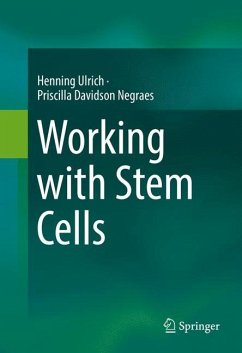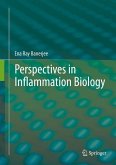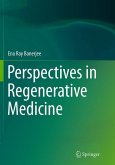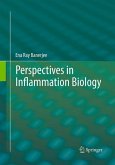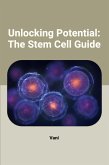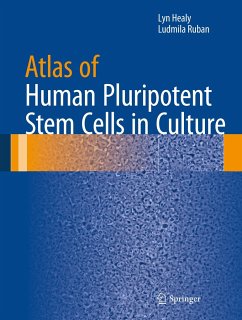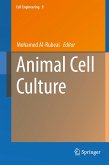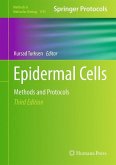- Gebundenes Buch
- Merkliste
- Auf die Merkliste
- Bewerten Bewerten
- Teilen
- Produkt teilen
- Produkterinnerung
- Produkterinnerung
The content covered encompass not only the theoretic and methodological aspects for culturing human pluripotent stem cells, but also the establishment of induced pluripotent stem cells and their differentiation into specific cellular subtypes. This book has the most updated methods and technologies in an accessible and clear language, presenting protocols developed and optimized by researchers that use them every day. Stem cell research is a growing field that offers the potential to comprehend mechanisms of neural development and tissue regeneration and maintenance as well as the…mehr
Andere Kunden interessierten sich auch für
![Perspectives in Inflammation Biology Perspectives in Inflammation Biology]() Ena Ray BanerjeePerspectives in Inflammation Biology116,99 €
Ena Ray BanerjeePerspectives in Inflammation Biology116,99 €![Perspectives in Regenerative Medicine Perspectives in Regenerative Medicine]() Ena Ray BanerjeePerspectives in Regenerative Medicine77,99 €
Ena Ray BanerjeePerspectives in Regenerative Medicine77,99 €![Perspectives in Inflammation Biology Perspectives in Inflammation Biology]() Ena Ray BanerjeePerspectives in Inflammation Biology116,99 €
Ena Ray BanerjeePerspectives in Inflammation Biology116,99 €![Unlocking Potential: The Stem Cell Guide Unlocking Potential: The Stem Cell Guide]() VaniUnlocking Potential: The Stem Cell Guide26,59 €
VaniUnlocking Potential: The Stem Cell Guide26,59 €![Atlas of Human Pluripotent Stem Cells in Culture Atlas of Human Pluripotent Stem Cells in Culture]() Lyn HealyAtlas of Human Pluripotent Stem Cells in Culture116,99 €
Lyn HealyAtlas of Human Pluripotent Stem Cells in Culture116,99 €![Animal Cell Culture Animal Cell Culture]() Animal Cell Culture155,99 €
Animal Cell Culture155,99 €![Epidermal Cells Epidermal Cells]() Epidermal Cells116,99 €
Epidermal Cells116,99 €-
-
-
The content covered encompass not only the theoretic and methodological aspects for culturing human pluripotent stem cells, but also the establishment of induced pluripotent stem cells and their differentiation into specific cellular subtypes. This book has the most updated methods and technologies in an accessible and clear language, presenting protocols developed and optimized by researchers that use them every day. Stem cell research is a growing field that offers the potential to comprehend mechanisms of neural development and tissue regeneration and maintenance as well as the development-related human diseases and the establishment of novel therapies. Questions of basic biology can also be exploited by this cutting-edge approach.
Produktdetails
- Produktdetails
- Verlag: Springer / Springer International Publishing / Springer, Berlin
- Artikelnr. des Verlages: 978-3-319-30580-6
- 1st ed. 2016
- Seitenzahl: 392
- Erscheinungstermin: 16. August 2016
- Englisch
- Abmessung: 241mm x 160mm x 27mm
- Gewicht: 696g
- ISBN-13: 9783319305806
- ISBN-10: 3319305808
- Artikelnr.: 44492787
- Herstellerkennzeichnung Die Herstellerinformationen sind derzeit nicht verfügbar.
- Verlag: Springer / Springer International Publishing / Springer, Berlin
- Artikelnr. des Verlages: 978-3-319-30580-6
- 1st ed. 2016
- Seitenzahl: 392
- Erscheinungstermin: 16. August 2016
- Englisch
- Abmessung: 241mm x 160mm x 27mm
- Gewicht: 696g
- ISBN-13: 9783319305806
- ISBN-10: 3319305808
- Artikelnr.: 44492787
- Herstellerkennzeichnung Die Herstellerinformationen sind derzeit nicht verfügbar.
Dr. Priscilla Davidson Negraes has a Bachelor degree in Biological Sciences at State University of Londrina (Brazil), where she also got her Master's degree in Genetics and Breeding by evaluating the antimutagenic effect of natural compounds. She completed her Ph.D. in Genetics at São Paulo State University (Brazil), after studying the relationship and relevance of epigenetics for the prognosis of human bladder cancer. Dr. Negraes joined the Neuroscience and Stem Cell fields during her postdoc at University of São Paulo (Brazil), when she worked on neural differentiation of stem cells and the characterization of neurotransmitters systems during cell fate determination. Next, she became a Visiting Scholar at University of California San Diego (USA), and started to model human neurological diseases using induced pluripotent stem cells. As a result of these experiences, Dr. Negraes developed an extensive knowledge in cell culture, cellular and molecular biology, and neural differentiation of stem cells. Currently, she is a reviewer for many scientific journals and works on modelling neurodevelopmental disorders to ultimately disclose new therapies and improve patients' quality of life. Prof. Henning Ulrich studied Biology at the Universities of Hamburg and Kiel (Germany) and performed his master thesis in Biochemical Parasitology, followed by a PhD. in Biochemistry and Neuroscience at the University of Hamburg, Germany. He completed his training by postdoctoral research at the Center of Molecular Neurobiology at the University of Hamburg and Cornell University, NY, the latter one financed by a fellowship of the American Heart Association. He came to the Institute of Chemistry at the Sao Paulo University as a visiting scientist, where he was then appointed as faculty member. Here he habilitated in Biochemistry, is currently Associate Professor and head of the laboratory of neuroscience, working on stem cells and mechanisms of neurogenic differentiation of diverse types of stem cells and stem cell techniques for possible therapeutic use of neurodegenerative disease. Dr. Ulrich has published more than 100 papers in peer-reviewed journals (H-factor of 25, more than 1800 citations), 3 books (two of them published with Springer), 14 book chapters and participated in three patents. His research results were commented in major Brazilian newspapers. His is acting as editorial board member of renowned journals, Associate Editor of Cytometry A and Academic Editor of PLoS ONE.
Chapter 1 Stem Cells: Principles and Applications.- Chapter 2 Human Embryonic Stem Cell Line Derivation.- Chapter 3 Adipose-Derived Mesenchymal Stromal Cells.- Chapter 4 Neural Differentiation of Rodent Neural Progenitor Cells & Isolation and Enrichment of Human Neural Progenitor/Stem Cells.- Chapter 5 Mice Post-Natal Subventricular Zone Neurospheres: Derivation, Culture, Differentiation and Applications.- Chapter 6 Very Small Embryonic-like Stem Cells (VSELs) and their Hematopoietic Specification.- Chapter 7 Neural Crest Stem Cell Cultures: Establishment, Characterization and Potential Use.- Chapter 8 Cancer Stem Cells: Issues with in vitro Expansion and Model Systems.- Chapter 9 Spontaneous Generation of Patient-specific Retinal Pigment Epithelial Cells using induced Pluripotent Stem Cell Technology. This chapter includes the generation of induced Pluripotent Stem Cell (iPSC).- Chapter 10 Differentiation of Human Pluripotent Stem Cells into Cortical Neurons.- Chapter 11 MotorNeuron Differentiation from Pluripotent Stem Cells: Development of the Technique, Synopsis of Protocols, and Summary of Current Applications.- Chapter 12 Derivation of Dopaminergic Neurons from Human Pluripotent Stem Cells Using a Defined System and/or Small Molecules.- Chapter 13 Differentiation of hiPSC-derived Cardiomyocytes.- Chapter 14 Endoderm Differentiation from Human Pluripotent Stem Cells.- Chapter 15 Pancreatic Differentiation from Human Pluripotent Stem Cells.- Chapter 16 Efficient Generation of Skeletal Myogenic Progenitors from Human Pluripotent Stem Cells.- Chapter 17. Genome Editing in Stem Cells.- Chapter 18 Neural Stem Cells: Functional Multipotency and Spinal Cord Injury Research Protocols.- Chapter 19 Stem Cells and Tissue Engineering.- Chapter 20 Scaffolds for Embryonic Stem Cell Growth and Differentiation.
Chapter 1 Stem Cells: Principles and Applications.- Chapter 2 Human Embryonic Stem Cell Line Derivation.- Chapter 3 Adipose-Derived Mesenchymal Stromal Cells.- Chapter 4 Neural Differentiation of Rodent Neural Progenitor Cells & Isolation and Enrichment of Human Neural Progenitor/Stem Cells.- Chapter 5 Mice Post-Natal Subventricular Zone Neurospheres: Derivation, Culture, Differentiation and Applications.- Chapter 6 Very Small Embryonic-like Stem Cells (VSELs) and their Hematopoietic Specification.- Chapter 7 Neural Crest Stem Cell Cultures: Establishment, Characterization and Potential Use.- Chapter 8 Cancer Stem Cells: Issues with in vitro Expansion and Model Systems.- Chapter 9 Spontaneous Generation of Patient-specific Retinal Pigment Epithelial Cells using induced Pluripotent Stem Cell Technology. This chapter includes the generation of induced Pluripotent Stem Cell (iPSC).- Chapter 10 Differentiation of Human Pluripotent Stem Cells into Cortical Neurons.- Chapter 11 MotorNeuron Differentiation from Pluripotent Stem Cells: Development of the Technique, Synopsis of Protocols, and Summary of Current Applications.- Chapter 12 Derivation of Dopaminergic Neurons from Human Pluripotent Stem Cells Using a Defined System and/or Small Molecules.- Chapter 13 Differentiation of hiPSC-derived Cardiomyocytes.- Chapter 14 Endoderm Differentiation from Human Pluripotent Stem Cells.- Chapter 15 Pancreatic Differentiation from Human Pluripotent Stem Cells.- Chapter 16 Efficient Generation of Skeletal Myogenic Progenitors from Human Pluripotent Stem Cells.- Chapter 17. Genome Editing in Stem Cells.- Chapter 18 Neural Stem Cells: Functional Multipotency and Spinal Cord Injury Research Protocols.- Chapter 19 Stem Cells and Tissue Engineering.- Chapter 20 Scaffolds for Embryonic Stem Cell Growth and Differentiation.

